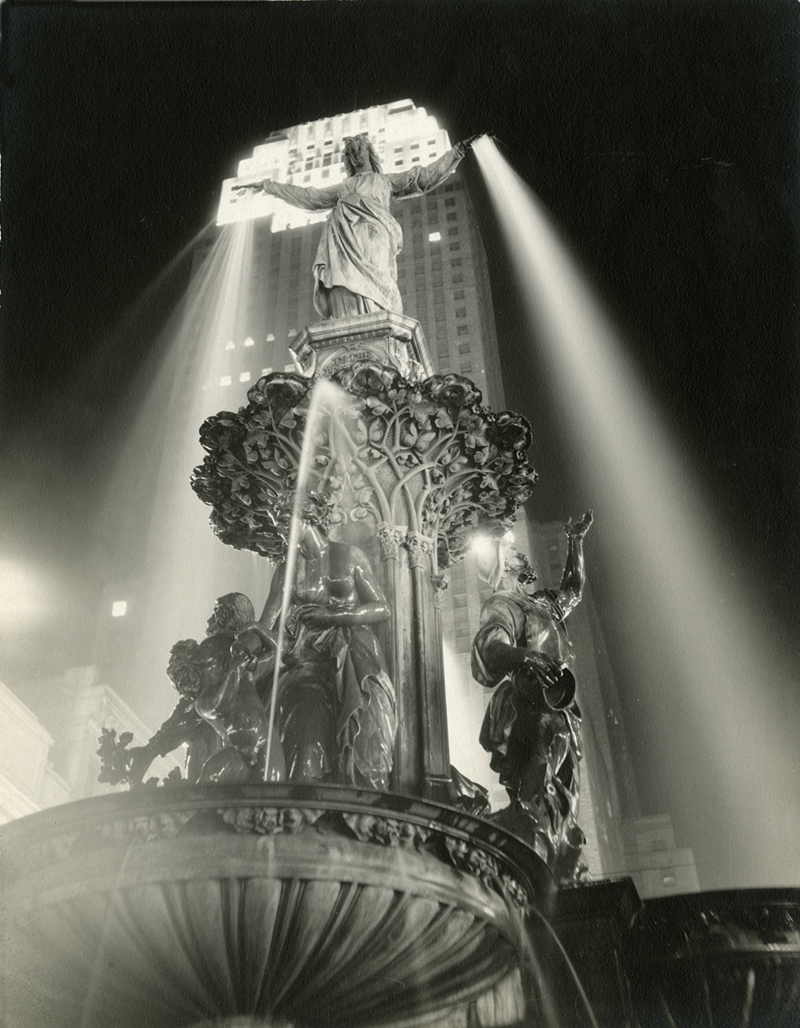While there are FotoFocus shows and events continuing into November and even longer, the October festival formally closed Saturday night with a boisterous, picture-perfect celebration, the Carnevil Halloween party at Newport’s Thompson House (formerly the Southgate House).
All rooms were jam-packed with people in imaginative costumes, and in the ballroom the DAAP Girls (outfitted for the night as the DAAP Witches) belted out a funky, soulful, garage-rock version of “Ghostbusters” far better than the cutesy original.
Best of all, for those who remember coughing and hacking their way through the old Southgate House, the place was non-smoking for this event and had signs up everywhere to enforce that. If it can keep up the pleasant smoke-free environment, Thompson House might just become the nightclub that counts in Greater Cincinnati. Still not sure if that will make me turn out for the upcoming Dying Fetus/Malignancy concert, but the place is definitely back on my radar.
Carnevil’s turnout also proved that FotoFocus, as an event, was on people’s radar. There had been some questioning of that earlier in the week, after moderate turnouts for two appearances by nationally significant photographers at Cincinnati Art Museum’s Fath Auditorium.
Laurel Nakadate gave the prestigious FotoFocus Lecture there on Oct. 24, presenting a slide show of the past 12 years of her sometimes-eyebrow-raising performative-video and still-photography work.
For one project, she wandered around truck stops and invited truckers to dance with her in their cabs. In another, she traveled across Canada by train and threw her underwear out the window each day, photographing the colorful results. (As far as I know, she did not get arrested for littering.) Someone asked about the inherent danger in some of her early work, which involved putting herself in erotic situations with strange men. “I look back at my early work and fear for my life,” she said. “But I’m really glad I made that work.”
Incidentally, one of her more recent projects — for which she showed slides — was to photograph herself crying everyday for one year. The “one year” motif seems to be such a strong one that some curator somewhere should devote a show to its variations. There’s plenty of material right here. At Michael Lowe’s Downtown gallery, site of the “Using Photography” FotoFocus exhibit featuring work by 1970s-era (and beyond) Conceptual Artists, there is an example of On Kawara’s “I Got Up” series. For 11 years (1968-1979), he sent friend picture postcards stamped with the time that he arose each day.
And when Todd Pavlisko was in town last week to plan for his “Docent” rifle-firing project that occurred Monday at Cincinnati Art Museum, he said that one piece in his resultant museum show next year will be displaying all the loose change he’s collected in a year. (He will gold-plate the coinage.)
At the other appearance of a photographer at CAM last week, Chief Curator James Crump discussed the future of photography books with Minnesota photographer/publisher Alec Soth and Darius Himes, a gallerist whose Radius Books publishes unusual photography creations.
Some in the audience wished the event would have featured much more of Soth and his fascinating photojournalistic work. He did discuss a current project, in which he and Brad Zellar are photographing election-eve everyday life in Michigan for his LBM Dispatch, which tries to quickly publish and distribute photo essays. (The work will then be displayed at Detroit’s Cranbrook Institute.)
But Himes did express admiration for the strangest Conceptualist book project I’ve heard of in a long time. That would be photographer Mishka Henner’s printed-on-demand Astronomical, twelve 506-page volumes representing, in total, a scale model of the solar system from the sun to Pluto. Many of the pages are blank, representing the great distances between planets in space. Himes did not say if you must order the whole set or just your favorite volume, but you can find out more at here.
I was able to spend some time last week with Barry Andersen, photography professor emeritus at Northern Kentucky University who has been a strong, forceful advocate for the importance of this form as both an artistic medium and a critical societal observer. His own show, the now-concluded Sky, Earth and Sea at Notre Dame Academy in Park Hills, served as a satisfying retrospective of thirty years of his work. Especially lovely were his gorgeous aerial-shot” Cloudscapes,” vivid inkjet prints from negative scans.
And as a curator, he put together a superb, sadly also now-concluded, show at NKU called Reporting Back, which surveyed the work of 14 documentary photographers whose thematic interests covered the globe. Each one’s work was presented as a series of photographs, a thematically related suite, to remind us of the journalistic impact of the photo essay. Ashley Gilbertson’s quietly moving “Bedrooms of the Fallen” visited the bedrooms of soldiers slain in Iraq and Afghanistan. Their solemnity was balanced by Jim Dow’s colorful portraits of idiosyncratically appealing, retro-Americana buildings. You can learn more about the show — and be introduced to some fine photographers — here.
FotoFocus has the potential to shine a lens on fine Cincinnati photographers of the past whose reputations could use a revival. One of the best shows to achieve that goal this year was Cincinnati Museum Center’s Photographic Legacy of Paul Briol: 1909-1955, which closes Thursday. Briol’s black-and-white images of the rhythms and architecture of Cincinnati life have a dreamy beauty, partly because he was not adverse to stripping in more dramatic skies and otherwise heightening an image’s dramatic effect.
The populism and humanism in his work are evident — Lewis Hine perhaps was an inspiration. An elderly African-American couple sits while the woman peels a potato; children in what seems to be an aged urban schoolroom pose with their stuffed animals. Those, along with images of the skyline, a roller coaster, Fountain Square, the riverfront, Rabbit Hash, Ky.’s general store, give life to that era’s Cincinnati.
Actually, the photo of his that moved me the most was in a different show, the concluded Images of the Great Depression: A Documentary Portrait of Ohio. It was by far the best thing in that exhibit. His contribution, an extraordinarily composed photo from 1935 called “Waiting for Work,” shows the looming shadows of men against a room’s wall. A sign reads, “Dirty Men Will Not Be Sent Out.” Briol may have arranged this image rather than just observed and captured it, but no matter. It magnificently speaks to the despair and denigration that the Depression brought.
One hopes 2014’s FotoFocus will find room to spotlight a few other Cincinnati photographers of the past who could use rediscovery — perhaps Nelson Ronsheim or George Rosenthal. Or, if you have ideas, send them along to me at [email protected]. In the Nov. 14 Big Picture column in CityBeat, I’ll address some suggestions for how we can keep the momentum going now that the interest level for photography has been raised.






